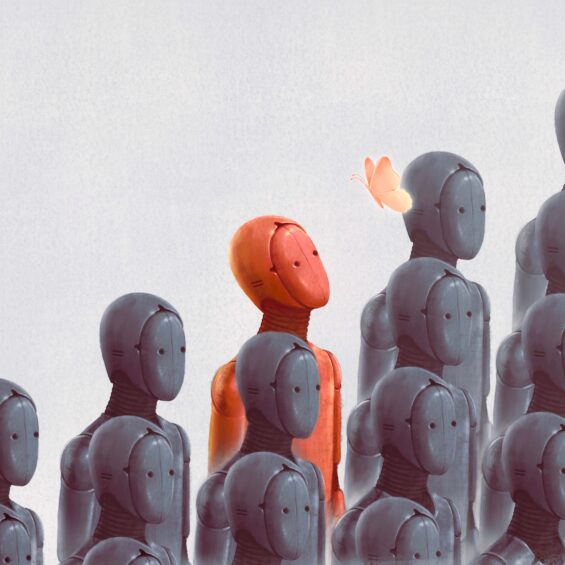Innovation and technology. Ask anyone and they’ll likely agree that the words fit together perfectly. But group innovation + technology + inclusiveness and you’ll probably hear a range of responses: inclusiveness helps; it’s important; it’s the right way to build teams; businesses should do more of it.
What you probably won’t hear is that inclusiveness is essential – Business and technology leaders need to change that. We need to ensure that organisations understand that inclusiveness and innovation have a mutually reinforcing relationship in which inclusiveness drives innovation in unanticipated directions. As economist John Manard Keynes said about his thinking process, “The difficulty lies not so much in developing new ideas, as in escaping from old ones.”
The same is true for technological innovation.
Innovation thrives on both the density and the diversity of ideas. The Darwinian competition in turn delivers better outcomes and better societies. The density part is pretty intuitive – get enough people in the same forum and you increase your percentages of covering all of the new idea bases. Author Steven Johnson, in “Where Good Ideas Come From,” postulates that the Age of Enlightenment was fueled in part by the sudden proliferation of coffee houses in 17th and 18th century Europe. as diverse (and suddenly highly caffeinated) minds from across society came together to debate and create the ideas that would accelerate human ingenuity and progress. Historians see this same phenomena in both modern cities and via the connectivity of the web, where once again a critical mass of ideas come together and create the sparks and fires of tomorrow’s innovation. So, we have the ‘density’ of ideas well in hand.
The diversity part is a bit harder. To get diversity of ideas we need to have diversity of people and perspectives. Otherwise, we miss out on the unknown ‘x-factor’ that can upend the status quo. You can certainly innovate with tunnel vision, but you’re likely only improving the tunnel. So, what mechanisms do we need to ensure that adjacent and outlier ideas are part of the debate – and that groups and perspectives beyond the current technology workforce are represented? If we don’t take concrete steps to ensure that those driving innovation are not all coming from a point of sameness, we find ourselves in a sameness trap.
Certainly there’s a moral argument here that might drive inclusiveness and embed it in our business and societal structures. It’s the right thing to do to be more diverse in hiring, team-building, and in vetting ideas. But there is also a simple practical perspective: diverse innovation drives better outcomes and better society. That’s true for nations and true for companies. There’s a results-driven reason to act.
For example, industries need different points of view to understand problems and uncover new possibilities. A company that knows its industry better than others could in the short term be wildly successful but ultimately it could also be sealing its demise because its focus is on perfecting and defending today’s business model rather than innovating to anticipate future trends. The business landscape is littered with the bones of Kodaks, Blockbusters and more. Transformative innovation and disruption is not about targeting your “today” business model. Rather, it relies on new, different thinking that reimagines “tomorrow’s” business model. A quick trip back to our coffee houses and we find that they were filled with people from across industry and from around the world — bringing fresh new perspectives on established thinking, and breaking down the guild-house walls of the day, if not the gender ones.
And the practical perspective isn’t confined to just individual business or sector evolution and survival. The world is facing significant issues and new technologies will help to improve the situation. Creating a better future and solving the biggest problems will require new approaches, new uses of digital technology and all the intellectual fire-power we have. Harnessing that fire-power means expanding the ranks of contributors. That’s inclusiveness. A unique world view and set of experiences can be the secret sauce that make incremental improvements cascade into disruption.
So what should we be doing?
First, businesses should stop looking for creative people and instead unleash the talent they have. It is not the one great idea, but the diverse perspectives on a problem or opportunity that can make a difference. Expansive solutioning means that every step is enriched not just through a different mind, but through a multitude of different minds contributing to and critiquing ideas. This means recreating the creative chaos of 18th century coffee houses or the dynamism of great cities in our very own companies. We need to create opportunities for many more people to participate, to learn, to contribute, and to refine ideas and thinking – a cross-fertilisation of existing minds, existing ideas and established practices across boundaries.
Second, having a supportive workplace culture is critical. Organisations need to judge an idea, not the person who created it. By its nature, innovation involves risk and uncertainty as it’s the creation of value through novel means. The more ideas the more likely one of them will succeed. Correspondingly, the more failures there must be. That means leaders need to encourage and reward risk taking, by separating the assessment of an idea from the assessment of the individual. Importantly, leaders need to also reduce the economic and political cost of failure through faster iterations of reviewing, stopping, adjusting or accelerating ideas – and formalizing the capture and communication of lessons learnt. The economic and design hurdle to get a project approved in many companies is so high that once approved, the political and career cost of stopping it becomes prohibitive. Better to test a small idea than try to slay a walking dead zombie project.
And third, inclusive innovation can’t be ad hoc – there must be a disciplined process. Companies need clear rules of the road that encourage and enable anyone to understand, contribute and participate without extensive training, tooling or funding. And they need to provide the foundation and the incentives to encourage and simplify participation. A defined innovation process, accelerator environments that provide mentoring, platforms, tools and data, and organisational constructs that allow for incremental funding, flexible goals and agile teams are all essential components. Getting to the start line should be the easy part. The goal is to create an environment that increases the volume, variety and velocity of idea – not to create a bespoke innovation path every time a problem or opportunity arises.
As MIT’s Andy McAfee said, it’s time for the “decline of the HIPPO (Highest Paid Person’s Opinion)”. In its place we need new ideas, structures, ownership and opportunities that will replatform, reenergise and reimagine a more sustainable and inclusive world.
Put simply: To be innovative in technology we need to simultaneously be innovative in how we view, operationalise and institutionalise inclusiveness.




